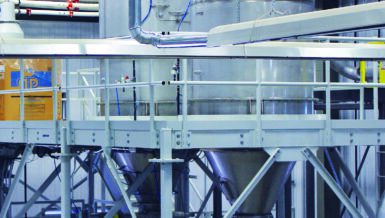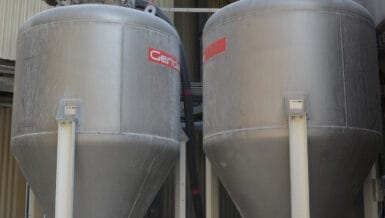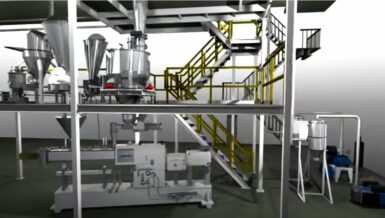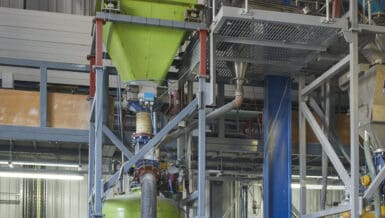What Are Sight Glasses in Pneumatic Conveying?
Sight glasses are transparent glass tubes or discs that act as windows into a pneumatic conveying system. They are usually held in place between two metal frames and secured with bolts and gaskets to provide an airtight seal. In older pneumatic conveying systems, a sight glass may be a glass tube that’s linked to a tank or gas inlet.
The window in sight glasses is usually made from borosilicate glass, which provides optical clarity, corrosion resistance, a good temperature range, and structural integrity. Soda-lime glass can also be used, as well as acrylic and Pyrex. Meanwhile, the metal frames that hold the sight glass in places are commonly made from stainless steel, which is known for its strength and abrasion resistance.
The materials used in sight glasses are crucial given the high-intensity environment of pneumatic conveying systems. A sight glass must be able to come into contact with the range of fluids and particles that pass through a pneumatic conveying system without tarnishing or degrading. Otherwise, it would compromise your visibility into the system, which needs to be as clear as possible.
What Are Sight Glasses Used For?
Also known as viewing glasses, sight glasses are used to observe the flow of materials inside pneumatic conveying lines without disrupting the internal environment. With precisely aligned glass and metal tubing, sight glasses have a smooth “straight-thru” design that offsets turbulence and optimizes visibility.
By allowing you to look inside your pneumatic conveying lines, sight glasses are critical when it comes to checking the levels of material passing through a critical point. For example, certain markers, like patterned backplates or striped inserts, can be used to determine the exact fluid level at a given point.
But sight glasses aren’t only used in pneumatic conveying systems. They have applications in a range of equipment, such as:
- Steam boilers, to monitor the water level
- Pharmaceutical equipment, to view fluids under extreme temperatures and pressures without risking flaking or explosion
- Gas or kerosene heaters, to ensure the pilot light and heater jets are working
- Dust collectors, to check the build up of debris in critical areas
Back to pneumatic conveying lines, sight glasses are used for two main purposes: indication and inspection. For example, a sight glass not only indicates if a material is flowing properly, it can also be used to monitor pipeline equipment, such as detecting blocked valves and strainers or a leaking steam trap.
For inspection purposes, sight glasses provide a way to monitor the color of a product as it passes through different sections of the pipelines. This can provide insight on product quality or degradation, as well as detect any color contamination.
6 Benefits of Sight Glasses
- Visual inspection without opening a closed system: Sight glasses provide a way to conduct a visual inspection of conveying lines without having to open the system. Not only does this promote regular inspection work, it also prevents outside contaminants, such as moisture or debris, from entering the closed system.
- Determines the presence and size of contaminants: Sight glasses can be used to identify the presence of contaminants in a system and how much of an issue they are. For example, if one becomes inundated with dirt, you know there’s an issue. Beyond dirt, sight glasses also identify metal fragments caused by wear on pneumatic components. Some even feature magnets that attract these metal fragments to them, helping you determine whether there are serious signs of wear.
- Won’t interrupt normal flow pattern of materials: Sight glasses are contoured to the inside diameter of a conveying line, giving them a seamless fit to ensure that they won’t interrupt the normal flow pattern of the conveyed materials.
- Flexible designs: Not only are there many different types of sight glasses to choose from, they’re also highly customizable. For example, the sight window can be made from either borosilicate glass, soda-lime glass, cast acrylic resin, or Pyrex, while the metal can be stainless steel, carbon steel, or aluminum. They’re also available in a wide range of sizes so that they can integrate seamlessly with your current system.
- Eliminate static electricity: As powder particles travel through pneumatic conveying lines, they collide with the pipe walls, leading to an accumulation of electrostatic charge. Sight glasses are permanently attached to a grounding strip in order to eliminate this build up of static electricity.
- At-a-glance: Perhaps the biggest benefit of sight glasses in pneumatic conveying systems is that with one glance, they allow you to detect fluid levels, product quality, color contamination, signs of pressure changes or blockages, the integrity of components, among many other aspects. This allows plant managers and engineers to continually monitor their system in an easy and cost-effective way.









































